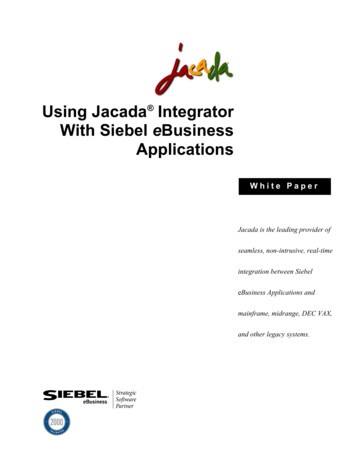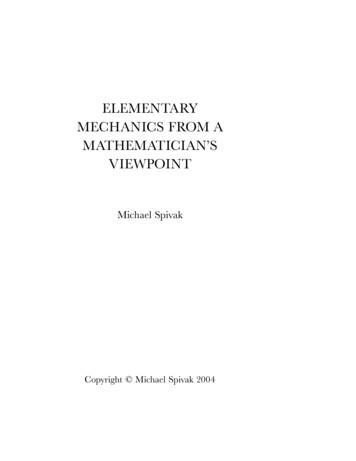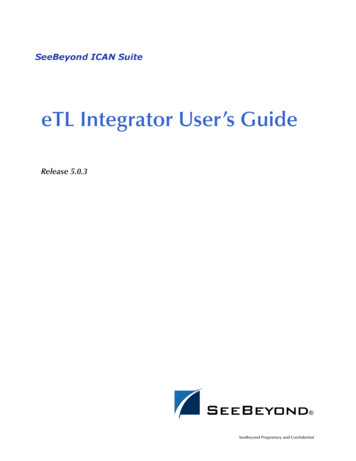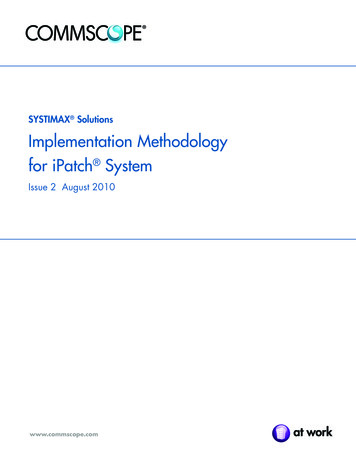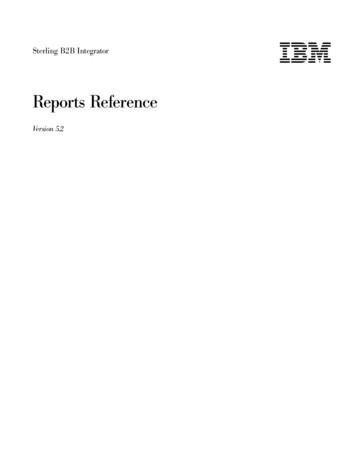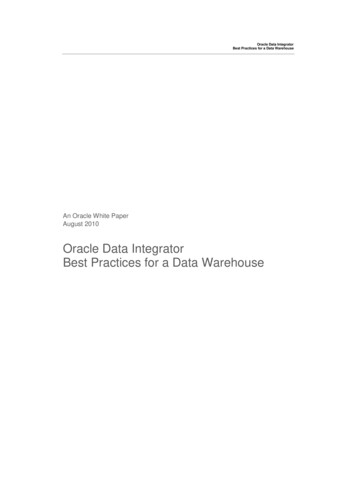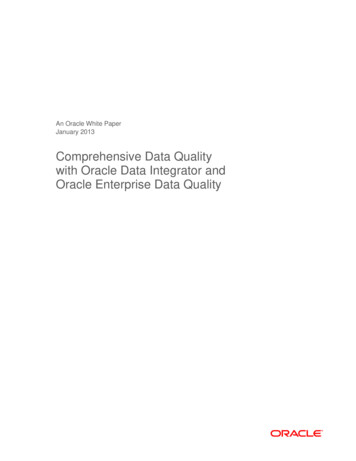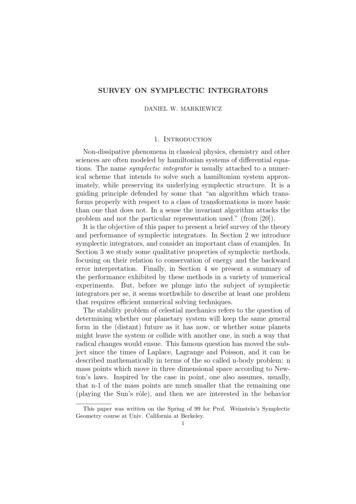
Transcription
SURVEY ON SYMPLECTIC INTEGRATORSDANIEL W. MARKIEWICZ1. IntroductionNon-dissipative phenomena in classical physics, chemistry and othersciences are often modeled by hamiltonian systems of differential equations. The name symplectic integrator is usually attached to a numerical scheme that intends to solve such a hamiltonian system approximately, while preserving its underlying symplectic structure. It is aguiding principle defended by some that “an algorithm which transforms properly with respect to a class of transformations is more basicthan one that does not. In a sense the invariant algorithm attacks theproblem and not the particular representation used.” (from [20]).It is the objective of this paper to present a brief survey of the theoryand performance of symplectic integrators. In Section 2 we introducesymplectic integrators, and consider an important class of examples. InSection 3 we study some qualitative properties of symplectic methods,focusing on their relation to conservation of energy and the backwarderror interpretation. Finally, in Section 4 we present a summary ofthe performance exhibited by these methods in a variety of numericalexperiments. But, before we plunge into the subject of symplecticintegrators per se, it seems worthwhile to describe at least one problemthat requires efficient numerical solving techniques.The stability problem of celestial mechanics refers to the question ofdetermining whether our planetary system will keep the same generalform in the (distant) future as it has now, or whether some planetsmight leave the system or collide with another one, in such a way thatradical changes would ensue. This famous question has moved the subject since the times of Laplace, Lagrange and Poisson, and it can bedescribed mathematically in terms of the so called n-body problem: nmass points which move in three dimensional space according to Newton’s laws. Inspired by the case in point, one also assumes, usually,that n-1 of the mass points are much smaller that the remaining one(playing the Sun’s rôle), and then we are interested in the behaviorThis paper was written on the Spring of 99 for Prof. Weinstein’s SymplecticGeometry course at Univ. California at Berkeley.1
of the system for all time. While the beautiful result of Kolmogorov,Arnold and Moser on perturbation of completely integrable systemsthrew new light on the subject, showing that stability is possible atleast in principle, recent numerical integration of the movement of theouter planets (from Jupiter outward) seems to imply that this is notthe case(see [21], [37], [40] and references therein, as well as [3], [28],[29]). Here symplectic integration, alongside more established and perhaps more trusted methods, has played an important role, and recentlythere have been some claims as to a theoretical reason explaining andconfirming these numerical experiments (see [21]).2. Symplectic IntegratorsLet Ω be a domainin R2d , endowed with the canonical symplecticPstructure ω dqi dpi . A smooth function H C (Ω) gives riseto the hamiltonian system of ODE’s(1)q̇i H piṗi H qii 1, . . . , d.In physics, Ω usually corresponds to phase space, and H to a hamiltonian for the system.Let h 0 be fixed. A (single-step) numerical scheme to solve sucha system consists of a function ψh,H : Ω Ω depending smoothlyon the step-size h and the hamiltonian H. Given an initial condition(p0 , q0 ), the approximate solution at time nh defined as (qn , pn ) can becomputed iteratively by(qn 1 , pn 1 ) ψh,H (qn , pn )It is important to remark that this definition is a temporary simplification, and that frequently the function ψh,H cannot be defined on thewhole domain Ω. Implicit integrators are examples of this phenomenon, as we will see shortly, but this map still makes sense locally, muchin the same way as flows of vector fields on a manifold.Now let φt be the flow of (1). The method ψh,H is said to be of orderr N if, as h 0,kφh (x) ψh,H (x)k O(hr 1 ),x ΩAt least heuristically, the source of the idea of order is that, to approximate φt (x) by dividing [0, t] into N parts and iterating ψh,H with astep-size h t/N we would perform O(h 1 ) computations, so as toexpect thatNkφt (x) ψh,H(x)k O(hr 1 ) · O(h 1 ) O(hr )2
Definition 1. A map ψh,H is called a symplectic integrator if it pre serves the symplectic form, i.e. ψh,Hω ω.Historically, symplectic integrators appeared for the first time in thepioneering work of de Vogelaere in the 50’s [39], and in the 80’s Ruth[30], Channell [8], Menyuk [27], and Feng [12, 13, 14] introduced methods arising from Hamilton-Jacobi Theory. We start, however, with theserendipitous independent discovery by Lasagni [23], Sanz-Serna [31]and Suris [36] that some implicit Runge-Kutta methods are symplecticfor an appropriate choice of parameters.In brief, for s a positive integer, an s-stage (implicit) Runge-Kuttamethod for the ODE(2)y 0 f (t, y), y(0) y0 t 0starts with a choice of a tableauc1 a11 · · · ass.cs as1 · · · assb1 · · · bsand settingyn 1 yn hsXbj f (tn cj h, ξj )j 1wherecj 0,sXcj 1j 1sXaji cj , j 1, . . . , sXbj 1i 1jtn nhand where the ξj ’s are given implicitly byξj y n hsXaji f (tn cj h, ξi )i 1Remark 1. The fact that the ξj ’s are given implicitly implies that tofind them uniquely (with some other numerical scheme, e.g. Newton’s3
method), one needs some conditions on f and h. For example, the inverse function theorem is often the theoretical result behind such uniqueness, and one requires f to be smooth, appropriately non-singular, andh to be small. In fact, generally ψh,H can be defined only for small h,depending on the starting point. This implies that frequently there isno uniform choice of h, and ψh,H cannot be defined on all of Ω. (Forless strict conditions, see [19]).It is clear that there is great freedom in the choice of parameters inthe Runge-Kutta (abbreviated RK) method. This means that muchof the art of RK methods rests on the ability to choose the remaining parameters wisely. First and foremost, one should make sure thatsuch a method is convergent, i.e. that as the step-size shrinks to zeroone actually recovers the exact solution. This is crucial, and realizable while still leaving free choices for the parameters, but we chooseto refer the reader to [19] for the details. Secondly, one searches forthe best possible combination of accuracy and speed, which involveschoices of step-size, and order for the method. Regarding order, it ispossible to show that for an s-stage RK method an appropriate choiceof tableau gives rise to a 2s-order method, so that there are RK methods of arbitrarily high order available. (for more details see [19] and[16])Now let M (mij )si,j 1 be the real s s matrix given bymij bi aij bj aji bi bjfor i, j 1, . . . , s. The matrix M comes up frequently in the study ofRK schemes and nonlinear stability (see [11]) and moreover Lasagni,Sanz-Serna and Suris showed thatTheorem 2.1. If M 0, then the corresponding implicit Runge-Kuttamethod is symplectic.Remark 2. According to Sanz-Serna [33], Lasagni has shown that, forRK methods without redundant stages (that is, when the stages cannotbe sub-partitioned into equivalent ones), this condition is actually necessary for the method to be symplectic. I could not find a (direct) prooffor this result in the literature, however Abia and Sanz-Serna in [1]prove the analogous result for Partitioned Runge-Kutta methods.Of course, the next issue is whether there are symplectic RungeKutta methods of arbitrarily high order (having a very high order isnot necessarily useful in applications, due to increase in computationsper step, error propagation and so on, but it is desirable that these beavailable). In fact, the classical s-stage Gauss-Legendre Runge-Kuttamethods are of 2s-order, and moreover4
Theorem 2.2. The Gauss-Legendre Runge-Kutta methods are symplectic.We direct the reader to [19] for the tableaux corresponding to theGauss-Legendre methods. Given these, the verification that M 0is immediate. For example, the 2-stage Gauss- Legendre method hastableau 31 131 264 46 13 131 426 460.50.5and it is clear that M 0 by inspection.Modifications of the idea of looking for symplectic integrators amongalready established algorithms have been of course carried much further. As an example, in many practical situations (e.g. the integrationof the movement of the outer planets), one has a separable hamiltonianH(q, p) T (p) V (q)and the system (1) decouples into two simpler ones, suggesting theuse of different schemes for each variable. RK methods of this typeare called Partitioned Runge-Kutta schemes (abbreviated PRK), andone can still show that there are symplectic PRK algorithms ([33]).Moreover, in this very special case one can choose the two componentsof the PRK method to be explicit (which is not possible in the generalcase), and thus makes the overall method more straightforward.Other methods exist in the Runge-Kutta class. There are for instanceRunge-Kutta-Nyström, and combinations of all of the above employingthe so-called Yoshida trick ([43]), which one could perhaps describe asa clever application of the Baker-Campbell-Hausdorff formula to theLie algebra of symplectic vector fields. We will take on this subject ina later section.Finally, it is important to remark that there exists a very differentclass of symplectic integrators that comes from the theory of generatingfunctions and the Hamilton-Jacobi equation, and these have found theirway to important applications. However, we will not be able to lookinto this subject, for the sake of briefness.3. Properties of Symplectic Integrators3.1. Conservation of Energy. Perhaps following the guiding principle of looking for algorithms that preserve the structure inherent to a5
problem, it is reasonable to inquire whether it is possible to augmentfurther a symplectic algorithm so that it also preserves the energy (i.e.the hamiltonian) of the underlying system. As an example of a situation where this is possible, Sanz-Serna provedTheorem 3.1. [31] A symplectic Runge-Kutta method leaves all quadratic first integrals of a hamiltonian system invariant, i.e. if yn t(qn , pn ) and G Gt M2d (R), then yn 1G yn 1 ynt G yn for all n.In particular, if a linear autonomous system is integrated with asymplectic RK method, than the energy will be conserved exactly (upto truncation errors, of course).This setting, however, is very restricted. Indeed, Z. Ge1 and J. Marsden provedTheorem 3.2 (Ge and Marsden[15]). Let K C (Ω) be a Poissonsub-algebra and assume that F K, {F, H} 0 F (z) F0 (H(z))for some smooth function F0 and let ψh be a smooth symplectic methoddefined for small h 0 from a generating function in K. If ψh conserves H exactly, then it is the time advance map for the hamiltonianup to a reparametrization of time.Remark 3. The assumption that ψh,H comes from a generating function is not restrictive. Locally every symplectomorphism arises fromsuch a function, and in that case the theorem has to be modified accordingly.The requirement on this theorem, that there be no first integralsof the given hamiltonian system independent of H in K, might seemvery strong at first sight. However, given a symplectic manifold M ,it is known that, under certain conditions, the set R(M ) of all hamiltonian systems of M that have no first integrals independent of theenergy is rather large. For example, L. Markus and K. Meyer [24] haveshown that when M is compact and 4-dimensional, R(M ) is actuallygeneric (in the sense of Baire category) in the set of all C hamiltoniansystems.Of course, the strong negative result of Ge and Marsden can beturned into a tool, in at least three different ways: 1) by enlistingthe energy variation with respect to the real solution as a measure ofthe deviation from it, 2) as an active way of “projecting” the symplectic solution to the appropriate energy level and so try to increaseaccuracy (which can cause difficulties with convergence and order estimates), or 3) adding the additional conserved quantities as constraints1while Zhong Ge appears with this name in [15], in the literature and in Mathscinet he is also listed as G. Zhong.6
via Lagrange multipliers, and other ad hoc techniques (see for example[4, 18, 19]).Remark 4. The numerical analysis community has devoted a greatdeal of attention to energy conserving methods, which are sometimesapplicable even to non-hamiltonian situations. The Ge-Marsden Theorem points to a very important question, then: given a specific hamiltonian system, should one use symplectic or energy conserving methodsto integrate it? Energy conservation guarantees, a priori, only that theapproximate solution is restricted to a codimension 1 submanifold ofΩ. When this dimension is big there is no reason to expect that thisinformation is very helpful. Nevertheless, energy conserving methodshave been available for a longer time, and hence have gone through considerable enhancement. On the other hand, symplectic integrators takeinto account the symplectic form, and hence to a certain extent a moreglobal and multi-dimensional behavior. Moreover, numerical experiments have shown that symplectic integrators have exhibited a boundedenergy error. In practice, since many problems are worth their owntailored solutions, general judgments on efficiency cannot be expected.3.2. Backward Error Interpretation. The concept of backward error interpretation comes from numerical linear algebra, and it refersto the ability of reinterpreting the numerical solution of a problem ina certain class as the exact solution of a perturbation of the originalproblem, without leaving that class [17].In our present context, this helps to explain the experimental observation that the energy deviation of the numerical solution of a hamiltonian system by a symplectic method remained bounded for long-timeintegrations (for a very interesting example of this fact, see [37]).Before we consider this phenomenon more closely, recall that if G ifa Lie group and g is its Lie algebra,Theorem 3.3 (Baker-Campbell-Hausdorff Formula). There is a neighborhood U of 0 in g and an analytic map θ : U U g such thatfor all X, Y U,exp(X) · exp(Y ) exp(θ(X, Y ))For a proof, and more details, the reader is directed to [38]. One cancompute the first terms of θ(X, Y ) to find11θ(X, Y ) X Y [X, Y ] ([X, [X, Y ]] [Y, [Y, X]]) . . .212Returning to hamiltonian systems, we have observed before that often in practical situations the hamiltonian is H separable, that is to7
say, H(p, q) T (p) V (q), and one can integrate each variable withdifferent methods (namely, integrating first the hamiltonian equationsfor T with an RK method, and then doing the same for V , which canbe done even exactly if these are especially simple). In terms of thehamiltonian vector fields X XT and Y XV (i.e. ıX ω dT andıY ω dV , following Yoshida [44] we can express this asψh,H exp(hX) · exp(hY )So that, by the BCH formula,ψh,H exp(θ(hX, hY ))for h small enough. Of course this argument is formal, since here theunderlying ‘Lie group’ is the group of symplectomorphisms of the manifold, and one cannot expect that θ(X, Y ) corresponds to a hamiltonianvector field. To havehψh,H exp(hH )it is necessary thathh2hH (p, q) T (p) V (q) {T, V } ({T, {T, V }} {V, {V, T }}) . . .212converges in some sense. Side-stepping this issue, however, we canclearly define for r 0 the r-order truncation Hrh byhH Hrh O(hr 1 )and so we have that, for a fixed amount of time, up to an arbitrary order the given symplectic integrator preserves a perturbed hamiltonian.When the sum is convergent, the perturbed hamiltonian is preservedfor all times.It is interesting to observe that this hints at a potential problemfor variable step-size symplectic integrators, for in this case one cannotexpect to conserve a certain approximate hamiltonian (different h’s andvector fields at each step prevent a profitable use of the BCH formula).In fact, experiments show ([6]) that an implementation of a symplecticmethod with variable step-sizes seems to destroy the advantages ofsymplectic integrators with respect to more classical ones. We referthe reader to [5, 6] for more information on this topic.hIn the case when H can actually be defined, one can understandmathematically the bounded oscillatory behavior of the energy in experiments with symplectic integrators. The powerful theory of Kolmogorov-Arnold-Moser on perturbations of completely integrable systemsstates that for a small perturbation of such a system the majority oforbits will be quasi-periodic (in the sense that the set of unstable orbitshas small measure in phase space. See [3] for more details on KAM8
theory). For the n-body problem, this accounts for the quasi-periodicbehavior of the energy error in symplectic integrations.Remark 5. By judiciously applying the BCH formula one can obtainmethods of arbitrarily high order. Indeed, if H is a separable hamiltonian H T V as before, with X, Y the hamiltonian vector fieldscorresponding to T, V respectively, thenexp(tX tY ) exp(tX/2) exp(tY ) exp(tX/2) O(t3 )which is a second order symplectic integrator. One can proceed further,by good choices of partitions of the interval, to attain higher orders (seeYoshida in [43]).4. Experimental PerformanceIn numerical analysis, actual speed and accuracy of computationsprovide the real measure of success of a method. Symplectic methodsare usually implicit (even though for certain special hamiltonians explicit schemes do exist [33]), and, moreover, at least heuristically onewould expect that the extra ‘symplectic requirements’ (for exampleM 0 for symplectic Runge-Kutta) might render these less advantageous for short time computations. This is actually the case, and anyadvantages should be sought for in long-time integrations, where thebuilt-in symplectic feature might for example have a favorable errorpropagation behavior.As we have mentioned in the introduction, one of the most interesting sources of numerical experiments employing symplectic integratorshas been astrophysics. In particular, Holman, Sussman, Wisdom andothers ([21, 37, 42]) have performed long time integrations in order tostudy the chaotic behavior of the outer planets. They have built onimportant previous work (see references in [37]), for example the 1million-year integration of Cohen, Hubbard and Oesterwinter [10], the5-million-year integration of Kinoshita and Nakai [22], and the 210million-year integration performed on the Digital Orrery [2] to namejust a few. In [41], for example, a symplectic method is introducedto tackle the movement of the outer planets for 1 billion years, andWisdom and Holman were led to the conclusion (in accord with earlierexperiments) that the motion of Pluto is chaotic. It is clear that whilesymplectic integrators seemed to behave satisfactorily in these experiments, in the sense that the gain in speed was not paid dearly withaccuracy at least in comparison to the Digital Orrery computation,statements regarding chaotic behavior based on numerical integrationare clearly worrisome. Nevertheless, trust in symplectic integrators9
seems to have been vindicated: very recently Holman and Murray [21]have proposed a theoretical explanation for these results. This subject,however, is historically full of twists and turns, and the jury is certainlystill out on such a recent development.Other experiments can be found in molecular dynamics, where somegood results have been achieved in the long-time integration of somecomplicated collisions or long-lived trajectories. In [34], for example,a comparison of many algorithms, including traditional top-of-the-lineones, is made, and the authors conclude that “the sixth-order [symplectic] integrator of Teloy is definitely better than all others, whichwe have now or earlier tested, and it has very good stability. We will useit henceforth for our routine calculations”. For more popular symplectic algorithms applied in molecular dynamics, including the “leapfrog”method, see [35].There are of course many other experiments (see [6, 7, 9, 27, 32, 33],the articles in [25] and references therein), but the conclusion appearsto be that the application of symplectic methods to long-time integrations is very successful in identifying most relevant qualitative featuresof hamiltonian systems. In these experiments, often some comparison is made with more traditional methods of same order of accuracy, which frequently require smaller step-sizes (and hence more iterations) to identify the relevant dynamics. While this seems encouraging, it also comes through that symplectic integrators have often beenbrought to problems already understood, sometimes to great extent,via the application of other methods. Even the case of the chaoticbehavior of the outer planets, one may rightfully defend, falls in thiscategory. This might account for the apparent reluctance that the numerical analysis community has had to embrace these tools. (It doesnot help, unfortunately, that symplectic integrators are often comparedwith traditional methods of the same order, sometimes even with fixedstep-sizes. This ignores the state-of-the-art mathematical technologyfor traditional methods, and the standing principle that one shoulduse variable step-size techniques whenever possible. The argument onthe side of symplectic integrators is that the fairness of comparing anewborn method with mature state-of-the-art ones that had years ofenhancement is at least questionable).Finally, it is appropriate to mention that although we have dealtmostly with systems of ODE’s, there are more recent methods thatapply geometric ideas to the numerical analysis of PDE’s. For thesedevelopments, we direct the reader to [26].10
References1. L. Abia and J. M. Sanz-Serna, Partitioned Runge-Kutta methods for separableHamiltonian problems, Math. Comp. 60 (1993), no. 202, 617–634.2. J. H. Applegate, M. R. Douglas, Y. Gursel, G. J. Sussman, and J. Wisdom,The outer solar system for 200 million years, Astron. J. 92 (1986), 176–194.3. V. I. Arnold, Mathematical methods of classical mechanics, Springer-Verlag,New York, 1989, Translated from the 1974 Russian original by K. Vogtmannand A. Weinstein, Corrected reprint of the second (1989) edition.4. K. E. Brenan, S. L. Campbell, and L. R. Petzold, Numerical solution of initial value problems in differential-algebraic equations, North-Holland PublishingCo., New York, 1989.5. M. P. Calvo and J. M. Sanz-Serna, The development of variable-step symplecticintegrators, with application to the two-body problem, SIAM J. Sci. Comput. 14(1993), no. 4, 936–952.6., Reasons for a failure. The integration of the two-body problem witha symplectic Runge-Kutta-Nyström code with stepchanging facilities, International Conference on Differential Equations, Vol. 1, 2 (Barcelona, 1991), WorldSci. Publishing, River Edge, NJ, 1993, pp. 93–102.7. J. Candy and W. Rozmus, A symplectic integration algorithm for separableHamiltonian functions, J. Comput. Phys. 92 (1991), no. 1, 230–256.8. P. Channell, Symplectic integration algorithms, Tech. Report Report AT-6ATN83-9, Los Alamos National Laboratory, 1983.9. P. J. Channell and C. Scovel, Symplectic integration of Hamiltonian systems,Nonlinearity 3 (1990), no. 2, 231–259.10. C. J. Cohen, E. C. Hubbard, and C. Oesterwinter, Elements of the outer planets for one million years, [Washington, Nautical Almanac Office, U.S. NavalObservatory; for sale by the Supt. of Docs., U.S. Govt. Print. Off., 1973], 1973.11. K. Dekker and J. G. Verwer, Stability of Runge-Kutta methods for stiff nonlinear differential equations, North-Holland Publishing Co., Amsterdam-NewYork, 1984.12. K. Feng, On difference schemes and symplectic geometry, Proceedings of the1984 Beijing symposium on differential geometry and differential equations,Science Press, Beijing, 1985, pp. 42–58.13., Difference schemes for Hamiltonian formalism and symplectic geometry, J. Comput. Math. 4 (1986), no. 3, 279–289.14., Symplectic geometry and numerical methods in fluid dynamics, Tenthinternational conference on numerical methods in fluid dynamics (Beijing,1986), Springer, Berlin, 1986, pp. 1–7.15. Z. Ge and J. E. Marsden, Lie-Poisson Hamilton-Jacobi theory and Lie-Poissonintegrators, Phys. Lett. A 133 (1988), no. 3, 134–139.16. C. W. Gear, Numerical initial value problems in ordinary differential equations,Prentice-Hall, Inc., Englewood Cliffs, N.J., 1971.17. G. H. Golub and C. F. Van Loan, Matrix computations, third ed., Johns Hopkins University Press, Baltimore, MD, 1996.18. E. Hairer, C. Lubich, and M. Roche, The numerical solution of differentialalgebraic systems by Runge-Kutta methods, Springer-Verlag, Berlin-New York,1989.11
19. E. Hairer, S. P. Nørsett, and G. Wanner, Solving ordinary differential equations,vol. I, second ed., Springer-Verlag, Berlin, 1993.20. R. W. Hamming, Numerical methods for scientists and engineers, McGrawHill Book Co., Inc., New York-San Francisco, Calif.-Toronto-London, 1962,International Series in Pure and Applied Mathematics.21. M. Holman and N. Murray, The origin of the chaos in the outer solar system,Science 283 (1999), no. 5409, 1877–1881.22. H. Kinoshita and H. Nakai, Motions of the perihelions of neptune and pluto,Celestial Mechanics 34 (1984), 203–217.23. F. M. Lasagni, Canonical Runge-Kutta methods, Z. Angew. Math. Phys. 39(1988), no. 6, 952–953.24. L. Markus and K. R. Meyer, Generic Hamiltonian dynamical systems are neither integrable nor ergodic, American Mathematical Society, Providence, R.I.,1974, Memoirs of the American Mathematical Society, No. 144.25. J. E. Marsden, G. W. Patrick, and W. F. Shadwick (eds.), Integration algorithms and classical mechanics, American Mathematical Society, Providence,RI, 1996.26. J. E. Marsden, G. W. Patrick, and S. Shkoller, Multisymplectic geometry, variational integrators, and nonlinear PDEs, Comm. Math. Phys. 199 (1998), no. 2,351–395.27. C. R. Menyuk, Some properties of the discrete Hamiltonian method, Phys. D11 (1984), no. 1-2, 109–129.28. J. Moser, Stable and random motions in dynamical systems, Princeton University Press, Princeton, N. J., 1973, With special emphasis on celestial mechanics, Hermann Weyl Lectures, the Institute for Advanced Study, Princeton, N.J, Annals of Mathematics Studies, No. 77.29., Is the solar system stable?, Math. Intelligencer 1 (1978/79), no. 2,65–71.30. R. D. Ruth, A canonical integration technique, IEEE Trans. Nucl. Sci. 30(1983), 2669–2671.31. J. M. Sanz-Serna, Runge-Kutta schemes for Hamiltonian systems, BIT 28(1988), no. 4, 877–883.32., Symplectic integrators for Hamiltonian problems: an overview, Actanumerica, 1992, Cambridge Univ. Press, Cambridge, 1992, pp. 243–286.33. J. M. Sanz-Serna and M. P. Calvo, Numerical Hamiltonian problems, Chapman& Hall, London, 1994.34. Ch. Schlier and A. Seiter, Symplectic integration of classical trajectories: Acase study, J. Phys. Chem. A 102 (1998), 9399–9404.35. R. D. Skeel, G. Zhang, and T. Schlick, A family of symplectic integrators:stability, accuracy, and molecular dynamics applications, SIAM J. Sci. Comput.18 (1997), no. 1, 203–222, Dedicated to C. William Gear on the occasion of his60th birthday.36. Yu. B. Suris, On the canonicity of mappings that can be generated by methodsof Runge-Kutta type for integrating systems ẍ U/ x, Zh. Vychisl. Mat. iMat. Fiz. 29 (1989), no. 2, 202–211, 317.37. G. J. Sussman and J. Wisdom, Chaotic evolution of the solar system, Science257 (1992), no. 5066, 56–62.38. V. S. Varadarajan, Lie groups, Lie algebras, and their representations, SpringerVerlag, New York-Berlin, 1984, Reprint of the 1974 edition.12
39. R. de Vogelaere, Methods of integration which preserve the contact transformation porperty of hamiltonian equations, Tech. Report No 4, Dept. Mathem.,Univ. of Notre Dame, Notre Dame, Ind., 1956.40. J. Wisdom, Chaotic behaviour in the solar system, Proc. Roy. Soc. London Ser.A 413 (1987), no. 1844, 109–129.41. J. Wisdom and M. Holman, Symplectic maps for the n-body problem, Astrophysical J. 102 (1991), 1528–1538.42. J. Wisdom, M. Holman, and J. Touma, Symplectic correctors, Integration algorithms and classical mechanics (Toronto, ON, 1993), Amer. Math. Soc., Providence, RI, 1996, pp. 217–244.43. H. Yoshida, Construction of higher order symplectic integrators, Phys. Lett. A150 (1990), no. 5-7, 262–268.44., Recent progress in the theory and application of symplectic integrators,Celestial Mech. Dynam. Astronom. 56 (1993), no. 1-2, 27–43, Qualitative andquantitative behaviour of planetary systems (Ramsau, 1992).13
tableau 1 2 p 3 6 1 4 1 4 p 3 6 1 2 p 3 6 1 4 p 3 6 1 4 0:5 0:5 and it is clear that M 0 by inspection. Modi cations of the idea of looking for symplectic integrators among already established algorithms have been of course carried much fur-ther. As an example, in many practical situations (e.g. the integration
